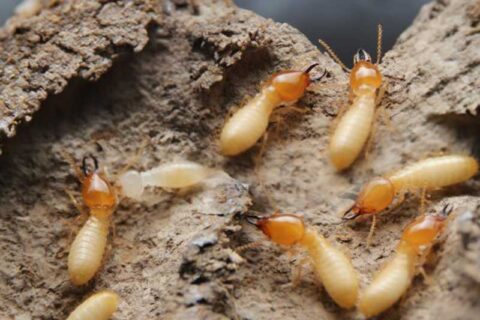Termite Tips Before Buying Your Home
Buying a first home is a major personal milestone for contemporary Americans, but it’s certainly not a matter to be taken lightly. Far too many of us sign the dotted line without taking into account the full range of considerations relating to the homeowning experience. Is the house really large enough for you and your family? Is it in a neighborhood you can come to love, or at least accept? What about the quality of the local schools?
As specialists in termite control, we can’t help you with any of that, but we are experts in termites and similar household nuisances, and we know all too well that people tend to overlook the possibility that their dream home already has a number of unwanted inhabitants.
Termites can be found almost everywhere across the United States, causing literally billions in property damage every year. (Official monetary estimates tend to vary widely, but it’s way up there in the billions, believe us.) It’s an issue that you can’t afford to ignore—especially if you’re preparing to sign the contracts for your new home.
The bottom line is this: Don’t purchase a home without first having it inspected for termites. Some prospective homeowners balk at this advice, however, because it requires them to assume responsibility for the fees involved with a professional inspection. However, a termite infestation could end up costing much more in the long run, so it’s not wise to try to save a few dollars on something as important as your house.
Having said that, it may be useful to explain the nature of termite infestations, explore some tips for spotting them, and, while we’re at it, go through a brief overview of the inspection process.
Termites: The Hidden Menace
The really insidious aspect of a termite infestation is the difficulty of detecting it. Termites are capable of doing an enormous amount of damage to a home while leaving little or no evidence noticeable from casual observation. They’re capable of chewing through a lot of material—wood, flooring, and more—without making a sound.
Because they avoid light, they tend to keep themselves safely hidden away and virtually invisible to casual inspection. By the time the damage does become obvious, it tends to be even worse than it looks. That’s because termites tend to devour wood from the inside and work their way out. They can chew away for literally years before you notice anything awry.
Unless you’re really experienced with termites, it’s best not to depend on your own observational powers to root out an infestation. This is definitely a job you should leave to professionals.
How Bad Is an Infestation?
Getting a professional termite inspection is clearly the way to go, then. Yet, what happens if the inspection uncovers termites in your dream home? That’s not good—but it doesn’t necessarily spell doom for your house-buying plans, either. The termite damage revealed during the course of the inspection may have happened years ago, which means there are no active termites to worry about, and the existing harm to the building could be minimal.
Even if there is an ongoing infestation, it may have developed fairly recently and not had time to cause serious problems. In this case, an experienced pest control specialist can clear away these unwanted visitors, which are likely to be relatively few in number. Again, however, you should consult a pest control expert to make these kinds of judgments, as the layman could easily misinterpret the signs they see.
What Happens During a Termite Inspection?
Once you have hired a termite/pest control inspector, they will perform a thorough examination of the premises in question, exploring everything from the basement to the attic. They will look for indications of termite presence on the property, as well as issues that could lead to an infestation in the future.
What exactly does the inspector look for? There are a number of illuminating signs of termite issues on the premises. One of these is the presence of mud tubes (also known as shelter tubes). These are small tunnels constructed by termites to allow them to travel safely through dangerous areas. Consisting of dirt and similar matter, these thin tubes typically can be found on your house’s foundation as well as other spots where insects may enter your home.
Mud tubes often resemble harmless dirt, so it’s easy for homeowners to simply overlook them, but, in fact, these makeshift tunnels give termites an effective entryway. Similarly, termites also tend to fill cracks in concrete, drywall, and construction joints. The presence of dirt crammed into these small openings is another potential sign of termite infestation.
Your inspector may also elect to take a look at your backyard and the area immediately surrounding your home, as these spots may harbor signs of an infestation that may, in turn, point to the possible presence of termites indoors.
Specifically, the inspector will be searching for wood—every termite’s main dish. Wood mulch or wood chips around the home tend to attract termites, which can then easily find their way into the nearby house. Wood fences are another termite attraction. Once termites encounter your delicious wood fence, they’ll scour the area for more edibles, and their search often leads them right inside your home. Basically, any type of wood on the property can attract termites—e.g., woodpiles, wood sheds, wood decks—and the closer these materials are to the house, the more likely that these annoying critters will find their way inside.
Naturally, the inspector will take a look at the interior of the home as well. This is where the expert eye of a trained professional tends to come in handy. As we’ve mentioned, termite infestations inside the home often leave few visible traces, at least to the average homeowner. An experienced technician, however, can spot the distinctive tunnel entrances that these insects often create while chewing through wood materials inside the house. They can also test wood components for indications that they’ve been hollowed out by ravenous termites.
In addition, a good termite inspector will be able to detect other types of problem-causing pests, such as roaches, ants, and bees.
If this sounds like a really elaborate procedure, don’t worry: All this should take half an hour to an hour and a half to complete. Following the inspection, the technician will fill out a report for your reference.
It should be emphasized that a termite inspection is distinct from a standard home inspection. Too many prospective homeowners assume that the standard inspection covers all aspects of the house’s condition, but this is not so. In many states, licensed home inspectors have no obligation to report the presence of termites or other wood-damaging insects. You should still get a standard home inspection, of course, but you should also hire a pest control expert for a separate termite inspection.
By now, it should be clear that a termite inspection should be considered an essential part of the home-buying experience, to be completed before signing the final documents. Some of you, though, may still try to convince yourselves that it’s just not worth the expense, especially in a tight economy.
What if we told you that you could procure a FREE termite inspection through MightyMite Termite Services? Normally valued at $200, this service is available upon request to prospective homeowners in Santa Clara County, Alameda County, San Mateo County, Contra Costa County, Santa Cruz County, San Benito County, and Monterey County. Please contact us today to schedule an inspection.








